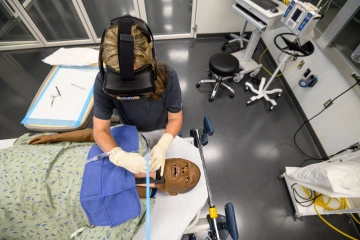
Kris Hanning/University of Arizona Health Sciences
Under the leadership of Allan Hamilton, professor in the University of Arizona College of Medicine – Tucson, the Arizona Simulation Technology & Education Center (ASTEC) is producing doctors and nurses trained to excel in real-world care.
Simulations develop basic skills but also ensure practice in uncommon procedures. And because they include data on trainees’ physiological states – saliva cortisol levels (a stress indicator) and sensors to measure heart rates and breathing – trainers can manipulate conditions to amp up
tension to roughly 95% of real-world, complex surgeries.
For example, students confronted with bleeding computerized mannequins not only learn to perform emergency cricothyroidotomies (a neck incision to allow air into the trachea), they train to do it blindfolded. Mastering procedures under pressure helps physicians later handle real-world strain with relative ease.
ASTEC also improves social and interprofessional skills. From tracking eye movements to recording speech, algorithms analyze how students talk to patients and how they interact with colleagues. Trainers can thus assess bedside manner and performance as part of a team.
Hamilton can see a future in which AIs accompany providers throughout their education and careers, offering guidance to continually improve performance. At the same time, he stresses that technology must never replace humanity.
“The art of medicine lies in the human element,” he says. “We should always remember that the ultimate goal of medicine is to care for and love our fellow human beings, and that cannot be replaced by AI.”
